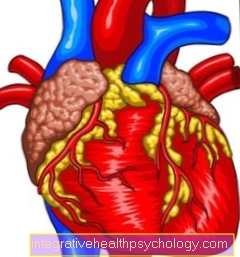Pain above the knee
introduction
Pain above the knee often occurs in athletes after overloading the affected region. But they can also occur if there is a disease in the knee joint itself or in other parts of the body such as the spine. Pain due to a pathological process can not only be localized at the place where it happened, but can also radiate. If pain occurs above the knee joint, the cause should be sought. Onset diseases are usually easier to treat than advanced diseases. For this reason, it is important not to wait too long to see a doctor if you experience symptoms.
In addition to a visit to the doctor and the targeted treatment of the present disease, home remedies can also provide relief. Cold applications and ointments help many patients with inflammatory reactions due to overuse or osteoarthritis. A mild pain reliever can also be taken for moderate pain, but should not be taken for more than a few days without a doctor's prescription.
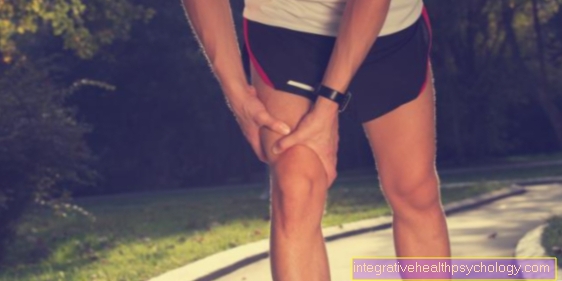
causes
The causes of pain above the knee are many. To find the cause, it is important to pinpoint the location of the pain. Accompanying symptoms can also provide clues as to the cause of the pain.
Above the knee pain that is localized on the outside is common in runners. They often arise from irritation of the iliotibial band. This clinical picture is called iliotibial band syndrome or runner's knee because it is so common in long-distance runners. The iliotibial band is a tendon plate that extends from the pelvic bone to the lower leg. When running, the tract can rub against the outer side of the thigh and this is what causes irritation. This creates the pain above the knee on the outside. This clinical picture is favored by knock knees or bow legs. Weak hip and pelvic muscles are another predisposition for the runner's knee.
If the pain is located above the front of the knee, this may be an indication of inflammation of the quadriceps tendon. The pain then typically increases when bending and climbing stairs. Bursitis in this area can cause similar pain. The quadriceps tendon connects the four-headed knee extensor muscle of the thigh to the kneecap. When overworked, it can become irritated, causing inflammation that causes pain.
Figure pain above the knee joint
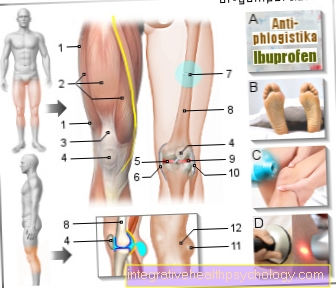
Pain above the knee
- Iliac-tibial tendon -
Iliotibial band - Quadruple thigh muscle -
Quadriceps femoris muscle - Quadriceps tendon
- Kneecap - patella
- Inner meniscus -
Meniscus medialis - Inner band -
Ligament collateral tibial - Broken bone (fracture)
- Femur - Femur
- Outer meniscus -
Lateral meniscus - Outer band -
Ligamentum collaterale fibulare - Baker's cyst (popliteal cyst)
- Popliteal muscle - M. popliteus
Causes:
Irritation of the iliotibial band
(Iliotibial band syndrome = runner's knee)
Inflammation of the quadriceps tendon
Strain of the popliteal muscle
Baker's cyst
Lesions (injuries) of the
Menisci or ligaments
Fracture (broken bone)
Rheumatoid arthritis
Therapy:
A - Anti-inflammatory
Medication (anti-inflammatory drugs)
B - Stand still
C - cooling ointments
D - laser therapy,
Ultrasound treatment
A transot all images by Dr-Gumpert can be found at: medical illustrations
If the pain is localized above the knee, a muscle irritation or injury to the rear of the thigh may be the cause. The trigger here is often excessive stress due to exercise. A strain or stress reaction of the popliteus muscle can cause similar pain. A Baker cyst can also cause pain above the back of the knee. A Baker cyst is a protrusion of the knee joint capsule. It often arises in the course of wear and tear diseases of the knee joint such as knee osteoarthritis. A Baker cyst is also common in rheumatic diseases such as rheumatoid arthritis. When exposed to stress, more synovial fluid is formed, which is pressed into this sac. This creates a resilient swelling in the hollow of the knee, which is painful depending on the severity of the severity. After a long break, the swelling will decrease because there is less synovial fluid in the joint when the patient is resting.
However, pain above the knee can also be caused by radiation of pain. Nerve root entrapment in the spine can cause radiating pain above the knee. The nerve roots of the spinal column segments L 2 or L 3 are often affected. Entrapment of the nerve roots can result from a herniated disc. Another cause is spinal stenosis. Wear or calcification leads to a narrowing of the spinal canal or the exit point of the nerve. This results in irritation of the nerve, which can be accompanied by pain in the leg above the knee, among other things. Nerve entrapment and radiating pain above the knee can also occur when tense muscles in the back or buttocks press on a nerve and thus constrict it.
Ligamentous disorders can also cause pain above the knee. For example, lesions of the external meniscus (please refer: External meniscus lesion) or the external ligament (see also: External ligament tear) cause pain above the knee outside, while localized pain from the medial meniscus inside (see also: Medial meniscus lesion) or medial ligament (see also: Inner ligament tear). Pain above the knee can occur with osteoarthritis of the knee. With osteoarthritis, wear and tear results in damage to the articular cartilage. This can lead to pain. Knee osteoarthritis occurs in many people in the course of their lives. Favorable factors are obesity and lack of exercise, but also permanent extreme stress on the knees and injuries such as cartilage damage or fractures that affect the joint surfaces. Misalignments of the leg axis also promote osteoarthritis. If there is a knock-kneed leg, the outer part of the knee is more stressed, whereupon the cartilage in this area wears out faster. The result is an osteoarthritis of the knee that is pronounced on the outside. With a bow-leg it's the other way around, the inside of the knee is more stressed. The result is an osteoarthritis of the knee that is accentuated on the inside.
Appointment with a knee specialist?

I would be happy to advise you!
Who am I?
My name is dr. Nicolas Gumpert. I am a specialist in orthopedics and the founder of .
Various television programs and print media report regularly about my work. On HR television you can see me every 6 weeks live on "Hallo Hessen".
But now enough is indicated ;-)
The knee joint is one of the joints with the greatest stress.
Therefore, the treatment of the knee joint (e.g. meniscus tear, cartilage damage, cruciate ligament damage, runner's knee, etc.) requires a lot of experience.
I treat a wide variety of knee diseases in a conservative way.
The aim of any treatment is treatment without surgery.
Which therapy achieves the best results in the long term can only be determined after looking at all of the information (Examination, X-ray, ultrasound, MRI, etc.) be assessed.
You can find me in:
- Lumedis - your orthopedic surgeon
Kaiserstrasse 14
60311 Frankfurt am Main
Directly to the online appointment arrangement
Unfortunately, it is currently only possible to make an appointment with private health insurers. I hope for your understanding!
Further information about myself can be found at Dr. Nicolas Gumpert
Above knee pain from fracture
Another cause of pain above the knee can be a fracture, for example after a car accident.
An X-ray should be taken to be sure that nothing has broken. Likewise, the kneecap may have slipped and then lead to pain above the knee.
Rheumatoid arthritis can also be the cause in elderly patients. This leads to inflammation processes in the knee area, which then lead to pain.
This pain can also occur above the knee and is most severe in the morning just before you get up.
Bacteria, viruses and fungi can also cause inflammation in the knee area, which is accompanied by swelling and pain, including above the knee.
Localization of the pain above the knee
Pain above the knee on the outside
If pain occurs on the outside of the leg above the knee, there is often irritation of the iliotibial tract. The iliotibial band is a tendon plate that extends from the pelvic bone to the lower leg. Overloading and misalignment can lead to irritation, the so-called iliotibial band syndrome or runners knee. The reason for the irritation is, in addition to a general overload, the rubbing on the outer side of the distal thigh, the lateral epicondyle. This results in pain on the outside above the knee or at knee level. This condition often occurs in long-distance runners, which is why it is also known as the runner's knee.Knock-knees or bow-legs are beneficial for malpositions. Weak hip and pelvic muscles are another predisposition for iliotibial band syndrome
However, pain in the outer area above the knee can also be caused by a radiation of pain. Lesions or injuries to the external meniscus or the external ligament can be the cause. Knee joint osteoarthritis that is accentuated on the outside, as often occurs with a knee malposition, can also be noticeable through pain above the knee. Nerve root entrapment in the spine can also cause radiating pain above the knee.
Pain above the knee on the back
Back pain above the knee may be due to muscle irritation or injury to the back of the thigh. The cause of this is often an overstrain due to exercise. Local therapy with the application of cold, ointment bandages and rest can often be sufficient to make the symptoms disappear.
Pain in the back above the knee can also arise due to a problem in the hollow of the knee. The popliteus muscle (popliteus) can be overstrained or strained. Another common disease in the hollow of the knee is Baker's cyst. This is a bulging of the knee joint capsule. It often arises in the course of wear and tear diseases of the knee joint such as knee osteoarthritis. With prolonged exertion, it fills with fluid, so that a bulging, elastic swelling in the hollow of the knee can be felt and an exciting pain arises. After sparing the joint, the cyst becomes smaller again. A doctor can also puncture the cyst, which will provide pain relief. If the cyst is large, surgery may be necessary.
When does pain above the knee occur?
Pain when bending
Quadriceps tendonitis can cause pain above the knee when flexing. When the knee is bent, the quadriceps tendon appears, which connects the quadriceps muscle to the kneecap. The quadriceps muscle is located on the front of the thigh and is responsible for knee extension.
If the quadriceps tendon is irritated and inflamed from overuse, the body reacts with pain when overuse. In this case, painful movements and loads should be avoided to allow the inflammation to heal. If pain occurs above the knee when bending, it is not uncommon for climbing stairs to be painful too.
Pain when climbing stairs
When climbing stairs, the knees and surrounding structures are more stressed than when walking normally. For this reason, complaints often first appear when climbing stairs, while normal walking and standing are still possible without pain.
Nevertheless, pain above the knee when climbing stairs is to be taken seriously. If the pain occurs for the first time and persists for more than a few days, a doctor should be consulted to find the cause of the pain. Often the cause is inflammation of the quadriceps tendon, which connects the quadriceps muscle to the kneecap and can become inflamed when overworked.
diagnosis

To make the correct diagnosis, one should:
- Ultrasound examination
or - an x-ray
or - a CT image
or - MRI of the knee
be made. The doctor must weigh up which is the best examination method to make the diagnosis after his suspected diagnosis. In most cases, he will choose the MRI of the knee, as many suspected diagnoses can be excluded or verified with an examination.
A disease of the cartilage of the kneecap is rather rare as the cause Chondropathia patellae.
This disease is particularly common in active girls and young women.
At the Stretching the knee Patients have increased pain below the kneecap as the cartilage degenerates there.
However, this pain can Radiate above the knee. Often a Kneesswelling on.
As you try to straighten your lower leg less because of the pain, there is a decrease (atrophy) of the anterior thigh musclesas this is for a Extension (Stretching the knee) are responsible.
therapy
As a therapy you should avoid overstressing the knee and you can also use anti-inflammatory drugs (Anti-inflammatory drugs) take in.
Above the knee, directly above the kneecap, there is a bursa, the prepatellar bursa. This bursa tends to become inflamed when overworked. Another cause of pain above the knee can therefore be an inflammation of this bursa (Bursitis).
Such inflammation is caused by an infection or a minor injury (Microlesion), for example wrong movement during sports.
Such bursitis can cause severe pain above the knee. In addition, swelling occurs and the area becomes warm and tender. If you cool the affected area, the pain becomes more bearable and the swelling is slightly reduced.
With increased stress, however, there is also more pain above the knee. For therapy, you should therefore keep the knee as still as possible for a while and avoid sport if possible. Cooling ointments and protection are usually sufficient to make the inflammation disappear. If this does not happen, laser therapy or ultrasound treatment can help. Drugs like ibuprofen also help reduce inflammation.
Above knee pain from Sinding-Larsen-Johansson disease
At the Sinding-Larsen-Johansson disease is a condition that mainly affects young men or boys who you knee overload too much (for example when jogging or playing football).
This leads to a very painful inflammation from the Detachment of bone particles above the kneecap, which then die (Bone necrosis) and thereby a inflammation cause.

.jpg)

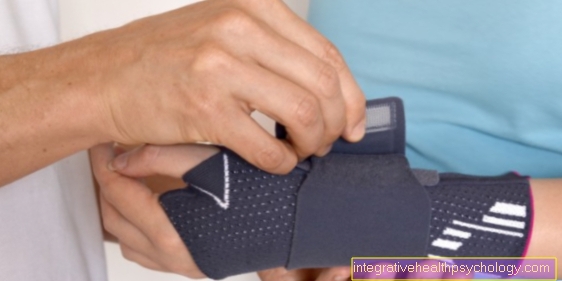
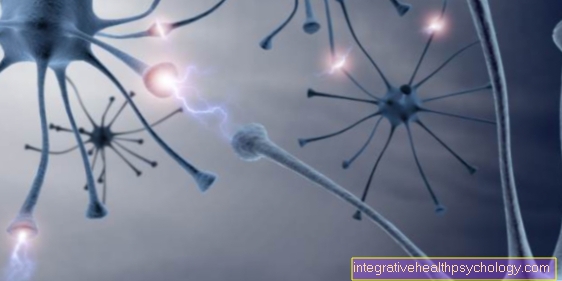



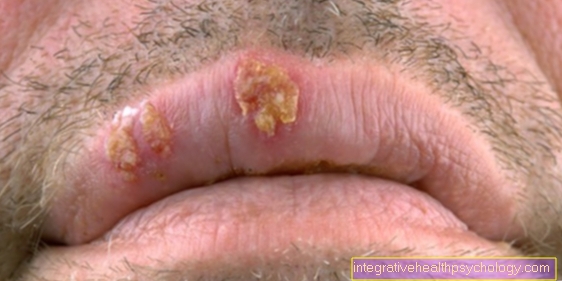











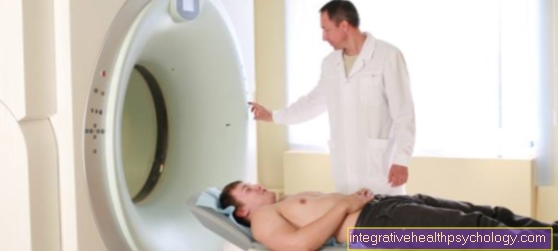

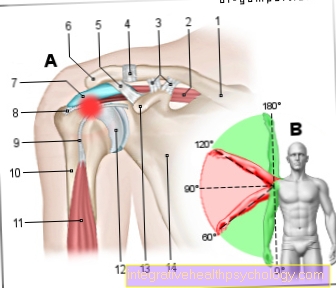

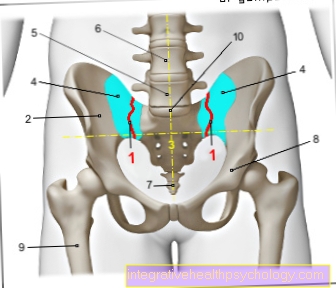
.jpg)


